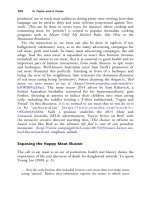The palgrave international handbook of a 504
Bạn đang xem bản rút gọn của tài liệu. Xem và tải ngay bản đầy đủ của tài liệu tại đây (25.75 KB, 1 trang )
Interventions with Animal Abuse Offenders
507
designed to assess animal abuse and/or clients’ relationships with animals are
not commonly used in the majority of practice settings. Most such instruments
have been designed for research, rather than clinical use. Further, most practices
are limited in the amount of time available for assessment, which may make it
impractical to add a dedicated questionnaire about animals to the intake packet
for all clients.
Our recommendation is that standard intake procedures in all intervention settings include at a minimum one screening question about animals,
with more detailed follow-up if the item is endorsed. On a domestic violence
crisis helpline, for example—where the length of the call may be determined
by how long the victim is safely able to remain on the phone—an advocate
may simply ask, “Are you concerned about any pets or other animals?”
Similarly, school counselors could ask if a child has or has ever had animals,
if s/he has ever lost one, and if s/he ever harmed or saw someone else harm
one.
Finally, practitioners may obtain information about animal abuse through
third-party sources, such as interviews with family members, teacher reports,
or presentence investigation reports. However, this can only occur if these
sources themselves report and/or document the animal abuse, which may be
unlikely for reasons similar to those described above. In general, though,
practitioners are wise to obtain information from multiple sources where
practical and ethical. In the case of socially undesirable and potentially illegal
behaviors such as animal abuse, third-party sources may be more likely than
the client to voluntarily disclose information about such behavior.
Developing Practitioner Familiarity
If, despite the above obstacles, an offender does receive a referral for intervention, or if information about animal abuse is revealed during intervention
for some other issue, the next question is whether there is a practitioner
competent to address the animal abuse. Although attention to human-animal
relationships is growing within the social sciences and helping professions,
most practitioners remain relatively unfamiliar with animal abuse or its
potential significance. Signal et al. (2013) found that most psychologists
reading descriptions of animal abuse by children did not identify the animal
abuse as a primary intervention target unless the psychologists suggested a
preliminary diagnosis of Conduct Disorder for the child.
This lack of awareness can be traced in large part to the relative absence of
animal topics in the professional training of human services personnel. Harm









